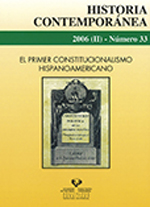Debate over forms of government and different alternatives of political association in the Rio de la Plata region
##plugins.themes.bootstrap3.article.main##
##plugins.themes.bootstrap3.article.sidebar##
Abstract
This paper reconsiders substantial aspects contained in the debate over different forms of government in the Rio de la Plata region after the crises of the Spanish Monarchy (1808) and the May Revolution (1810), in an effort to clarify the relationship between the emergence of sovereign forms associated to urban centers and the territorial dimension of the debate's central lines .In fact the tension between different towns and the nation as a unique subject was more vigorously expressed in the second attempt of constitutional organization (1824-1827) than in the first (1816-1819). When the cities started the process by which they became autonomous states the effects of the long lasting Hispanic crises over the central role performed by the Hispano-American towns became evident. After 1820 the appearance of some type of autonomous sovereignty should not only be interpreted as a response to the crisis but as starting point of a new type of order within the state. The tension among towns (urban sovereignty) States (provincial sovereignties) and Nation (Rio de la Plata sovereignty) is reflected in the debate hold during the Constitutional Congress of 1824-1827.
##plugins.themes.bootstrap3.article.details##
Authors publishing in the journal Historia Contemporánea agree to the following terms:
- Authors retain full copyright of their papers, but also grant copyright to the academic publisher (UPV/EHU Press) for the purposes of copyright management, vigilance and protection.
- Papers are by default published with a non-restrictive Creative Commons CC-BY-NC-ND 4.0. You are free to: Share, copy and redistribute the material in any medium or format. The licensor cannot revoke these freedoms as long as you follow the license terms. Under the following terms:
Attribution — You must give appropriate credit, provide a link to the license, and indicate if changes were made. You may do so in any reasonable manner, but not in any way that suggests the licensor endorses you or your use.
NonCommercial — You may not use the material for commercial purposes.
NoDerivatives — If you remix, transform, or build upon the material, you may not distribute the modified material.
No additional restrictions — You may not apply legal terms or technological measures that legally restrict others from doing anything the license permits.
- If an author requires a more restricted CC license (e.g. CC-BY-SA), this can be provided by contacting our publisher at: publications@ehu.eus
- In particular, and without having to request additional permission, CC BY-NC-ND licensed papers can be deposited in institutional repositories and academic web sites.
- Postprints (i.e. accepted but non-edited versions of the manuscript) can also be pre-published online, providing acknowledgement of authorship and source is specified as above.
For non-standard uses of papers or materials published in Historia Contemporánea, please contact our publisher UPV/EHU Press at: publications@ehu.eus

